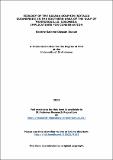Files in this item
Ecology of the Guiana dolphin (Sotalia guianensis) in the Southern area of the Gulf of Morrosquillo, Colombia : implications for conservation
Item metadata
| dc.contributor.advisor | Hammond, Philip S. | |
| dc.contributor.advisor | Wells, Randall | |
| dc.contributor.author | Dussán-Duque, Beatriz Salomé | |
| dc.coverage.spatial | xi, 229 | en_US |
| dc.date.accessioned | 2013-11-04T16:03:40Z | |
| dc.date.available | 2013-11-04T16:03:40Z | |
| dc.date.issued | 2013-11-29 | |
| dc.identifier | uk.bl.ethos.581843 | |
| dc.identifier.uri | https://hdl.handle.net/10023/4153 | |
| dc.description.abstract | Sotalia guianensis is listed as “Data Deficient” by the IUCN and as “Vulnerable” in Colombia. This study aimed to advance understanding of the ecology of this species and its habitats, and to provide information to conservation management in the southern Gulf of Morrosquillo, Colombia. Systematic boat-based surveys were conducted during 395 days in 2002-2006 and 2009-2010, following established routes. Total survey effort was 15,199 km in an area covering ~ 310km². Fine scale habitat use and behavioural modelling, photo-identification and mark-recapture techniques were used to analyze the ecological patterns for this species. The most recent abundance estimate of dolphins using the study area during dry and rainy seasons, varied from 225 (CV = 0.34; 95% CI: 118-426) to 232 (CV = 0.32; 95% CI: 127-246). Annual survival rate is estimated at 0.948 (95% CI = 0.876-0.980). Overall density was 0.74/km². Dolphins were present year-round in the whole study area. Results indicate that they do not use the study area uniformly and that the use of particular zones is related to eco-geographic variables. Dolphins showed a preference for waters greater than 3m in depth with a slightly increased preference for waters about 5m and 15-25m deep. The average group size was nine individuals. Some individuals show long-term high site fidelity to some zones within the study site boundaries. Even though the site fidelity to feeding areas varied individually, all the individuals focused primarily on one specific area. Foraging was among one of the most predominant behaviours observed. The individual movements show that some dolphins use both bay and gulf waters. Dolphins show a range of surface cooperative foraging and feeding strategies. These cooperative behaviours were influenced by zone, group size and prey type. Based on these results an area of special management for the species will be created in Colombia. | en_US |
| dc.language.iso | en | en_US |
| dc.publisher | University of St Andrews | |
| dc.subject | Sotalia guianensis | en_US |
| dc.subject | Vulnerable | en_US |
| dc.subject | Habitat modelling | en_US |
| dc.subject | Abundance | en_US |
| dc.subject | Survival rate | en_US |
| dc.subject | Site fidelity | en_US |
| dc.subject | Cooperative feeding | en_US |
| dc.subject | Conservation | en_US |
| dc.subject.lcc | QL737.C432D8 | |
| dc.subject.lcsh | Tucuxi--Ecology--Colombia--Morrosquillo, Gulf of | en_US |
| dc.subject.lcsh | Tucuxi--Conservation--Colombia--Morrosquillo, Gulf of | en_US |
| dc.subject.lcsh | Tucuxi--Habitat--Mathematical models | en_US |
| dc.subject.lcsh | Cetacea populations--Estimates--Colombia--Morrosquillo, Gulf of | en_US |
| dc.title | Ecology of the Guiana dolphin (Sotalia guianensis) in the Southern area of the Gulf of Morrosquillo, Colombia : implications for conservation | en_US |
| dc.type | Thesis | en_US |
| dc.type.qualificationlevel | Doctoral | en_US |
| dc.type.qualificationname | PhD Doctor of Philosophy | en_US |
| dc.publisher.institution | The University of St Andrews | en_US |
| dc.publisher.department | Sea Mammal Research Unit, University of St Andrews and Sarasota Dolphin Research Program, Mote Marine Laboratory, USA | en_US |
This item appears in the following Collection(s)
Items in the St Andrews Research Repository are protected by copyright, with all rights reserved, unless otherwise indicated.

